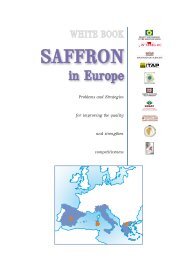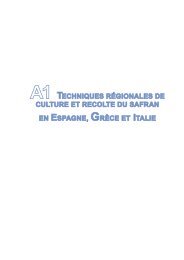Annex White book.pdf
Annex White book.pdf
Annex White book.pdf
Create successful ePaper yourself
Turn your PDF publications into a flip-book with our unique Google optimized e-Paper software.
The second formula (b) is more efficient when applied gradually,right before the planting of a new cultivation, since it allows the N-P-Kto dissolve better and consequently to be absorbed by the plant in amore balanced way.In Sardinia, manure is added to a large part of the field during fall ofthe year precedent to the commencement of cultivation. The amount variesbetween 30 – 40 mg of ripe manure per hectare (sheep – ox – horse).In addition to organic elements, some cultivators use mineralizedmaterials by adding small amounts of mineralized nitrogen fertilizers (forinstance urea or ammonium nitrate) during the end of winter in orderto activate plant activity. Seldom, three parts of fertilizers (8/24/24) areused in the fall, after flowering.1.3.3 Planting1.3.3.1 Bulb sizesIn Castile-La Mancha, studies have demonstrated the crucial importanceof bulb sizes for the number of flower buds during the first year ofcultivation. In the following years, size loses gradually its importance.In the third flowering year no difference is observed regarding the rateof the dry stigmas found on bulbs in various sizes.In Western Macedonia, there is no clear definition in terms of size,but generally, the use of small bulbs is avoided.In Sardinia, the biggest bulb diameter varies between 2,5 and3 cm. The smaller bulbs are planted in a row at the margin of thefield.A1.3.3.2 Planting depthDepth is crucial for the formation of the stigmas.In Castile-La Mancha, planting depth varies between 15 and 20cm. Bulbs are planted in such a way so as not emerge to the surface.Reproduction of the bulbs takes place during the following years ofcultivation.100




